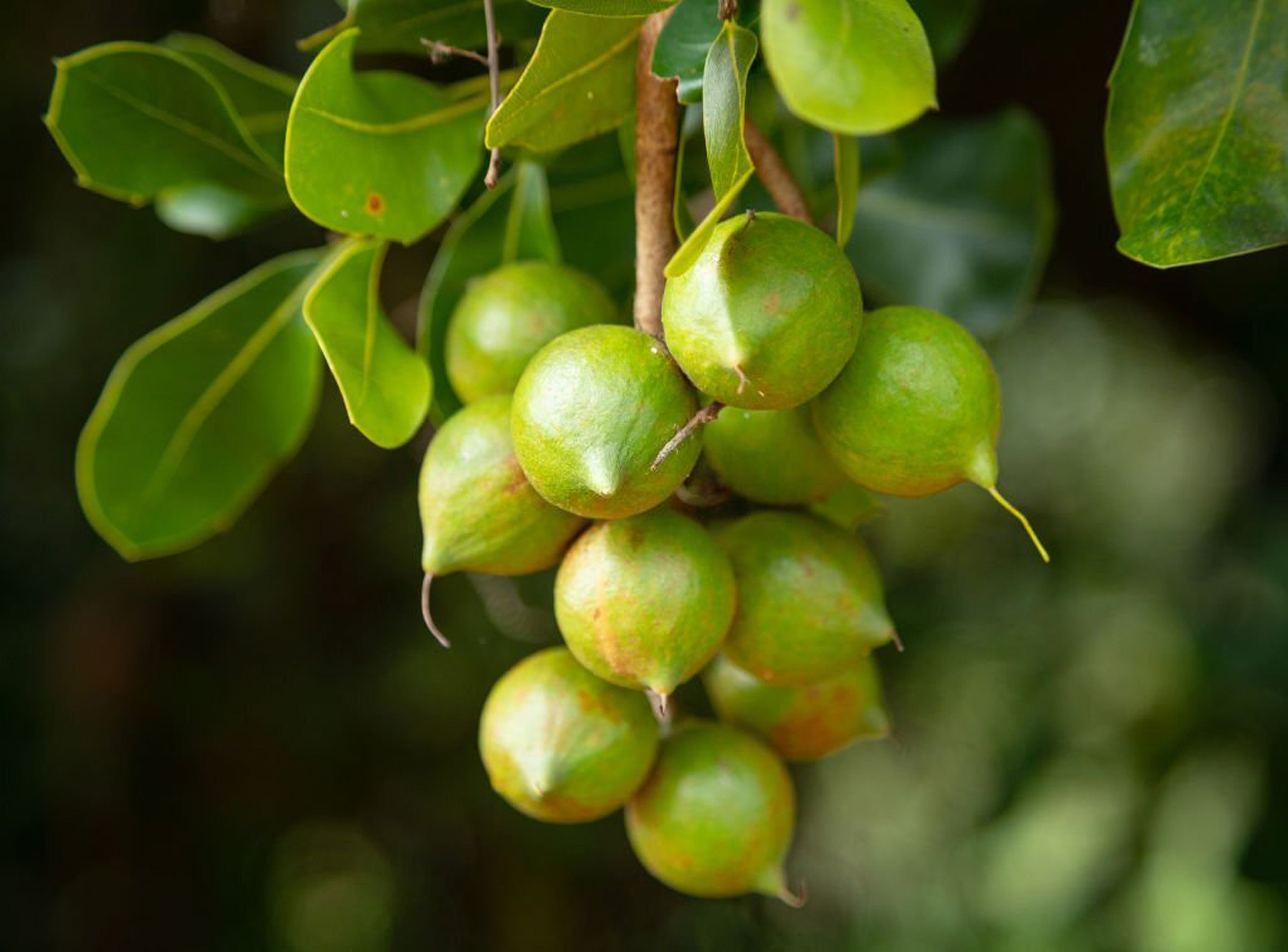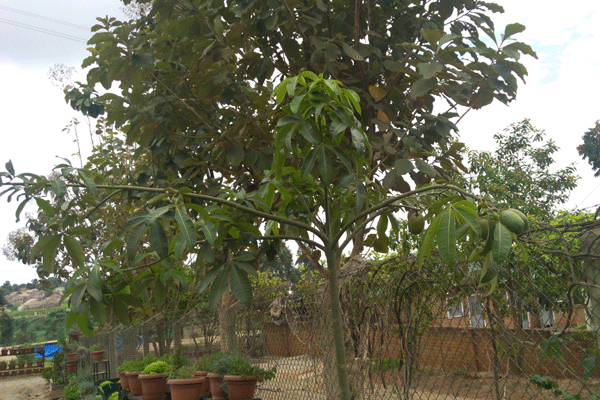Prime
Drumming the beat of macadamia

Macadamia nuts growing on a tree. Farmers are adivsed to spray them with pesticides. PHOTO/courtesy
What you need to know:
- A wonder tree with delicious buttery nuts that taste like cashew nuts, macadamia is set to benefit farmers, especially those who embrace agroforestry.
- Due to its high value, the government has made it more affordable through provision of subsidised seedlings.
Macadamia, hailed as the world’s most expensive nut, is a wonder crop progressive farmers need to pay attention to. In 2019 Uganda sold 201 tonnes of macadamia nuts. Between 2017 and 2019, macadamia nut exports grew by 139.29 percent.
In Uganda, few farmers such as Amafh Farms in Mityana District grow macadamia for commercial purposes.
According to Hussein Liaquat, an agronomist at Amafh Farms, there is a great need to scale up production by involving more farmers in the production.
Naads tips farmers
In partnership with Amafh Farms, the National Agricultural Advisory Services (Naads) are giving farmers 200,000 seedlings in an effort to promote macadamia growing in the country.
“This is a great opportunity for farmers,” Liaquat says.
The farm sells macadamia seedlings at Shs10,000 each. To plant an acre, a farmer requires about 100 seedlings, requiring a minimum of Shs1m.
With the government seed subsidy that comes with free extension services, a farmer needs to only register and qualify for the 70 percent subsidy.
Khadija Nakakande, the head communication at Naads says through the cost-sharing arrangement the farmer only pays 30 percent to the identified nucleus farmer. The first beneficiaries started planting last year in August.
Training farmers
Liaquat says they train farmers, give them seedlings and then buy back the produce from them.
Amafh is relying on its 700 acres under macadamia cultivation in Nambaale but seek at least 40,000 out-growers on top of the 1,000 farmers on board to achieve their market targets.
And the government is keen.
The Agriculture Sector Strategic Plan lists 12 priority commodities, namely: bananas, beans, maize, rice, cassava, tea, coffee, fruits and vegetables, dairy, fish, livestock (meat), and four strategic commodities, namely; cocoa, cotton, oil seeds, and oil palm. In 2020, the Ministry of Agriculture, Animal Industry and Fisheries (Maaif) included macadamia on the priority crops in Uganda because of its economic value.
Macadamia oil
Currently, macadamia nuts are used for confectionary, baking, ice cream, and snack food industries. Because of the oil’s rich feel, it is also suitable for heavy creams and skincare formulas.
Oil that is extracted from the culled nuts is commonly used in soaps, sunscreens, and shampoos, while the remaining press cake can be used in animal feed.
While the kernel and oil are the main products of macadamia nuts, both the shells and the husks also have uses. Macadamia shells can be used as mulch as well as fuel in macadamia nut processing. Macadamia husks can be used as mulch or compost for fertiliser.
Why macadamia
Macadamia farming is a lucrative venture driven by increasing demand and good prices which make it an ideal venture for low-income earners.
A kilogramme of macadamia nuts goes for between Shs3,000 and 4,000 making a farmer as much as Sh30m from an acre annually.
Before one finally makes up their mind to start growing macadamia, they may need to consider a few factors.

Macadamia farmer displays her nuts. Photo/Courtesy
“Beyond the economics, macadamia trees provide other benefits by decreasing the carbon footprint,” he says.
Even then, farmers seeking a fortune have an opportunity to enter the business.
On the international market, macadamia nuts are called the ‘brown gold’ due to its nutritional and economic value.
According to Selina Wamucii, an end-to-end food sourcing company, the approximate price range for macadamia nuts from Uganda is about Shs10,000 per kilogram on the global market.
Trees start producing at two years but substantial yields start at about seven years.
With a tree expected to produce about 12kg at maturity, a hectare of a well-managed orchard with spacing of 8X4m (312 trees per hectare), can yield 3.5 to 4 tonnes of in-shell nuts per year.
Health wise, consumption of macadamia is a lease of life. Though the nuts contain an overwhelming amount of saturated fat at 60 percent, about 56 per cent is unsaturated, it makes the nuts suitable as vegetable oil. The nut aids in digestion due to its 36 percent dietary fibre content. There is a protein amount of 16 percent of the daily value for bodybuilding.
The fruit also contains a volume of magnesium of more than 32 per cent of the daily needs for maintaining bone structure. Though the vitamin C content is low at 2 percent, it is compensated by a 20 percent concentration of iron which treats chronic diseases, besides boosting the oxygen part of blood.
Liaquat says macadamia has several products that are made out of it. These include cooking oil, as an ingredient in cookies, chocolate and ice cream, among others. The leaves can be used as animal feed, and the hard seed coat can be used for cooking.
Production
Though a mature tree will produce between 80kg and 300kg of nuts, most farmers harvest between 30kg and 50kg, and incur needless production costs.
Experts recommend starting a plantation with grafted seedlings which can be obtained from certified nursery operators.
Liaquat says that macadamia trees are generally vulnerable during the first four years until they establish a canopy. A good tree, he says, can produce nuts for 40 years.
According to the production handbook by Maaif, three preferred varieties are recommended in Uganda. They include; Muranga (MRG20), Kiambu and Kirinyaga.
Agronomy
Kiambu, which has red-ended leaves, is good for highlands while Kirinyaga, a bunchy type, with relatively small fruits, is preferred in lowlands. One of its shortcomings is that it does not withstand winds.
Muranga is the cross between Kirinyaga and Kiambu and can withstand harsh conditions.
“Farmers can seek advice from extension workers on the most ideal variety they need to plant but we recommend the cross,” Nakakande says.
Macadamia is preferably planted in deep, well-drained soils. The trees need a gentle slope because macadamia trees are very susceptible to canker diseases in poorly drained soils.
The recommended spacing is 7.5X7.5m accumulating 75 trees an acre or 8X5m which results in 100 trees.
Macadamia trees need a lot of management for profit and good nut quality.
He explains that inter-planting two cultivars of macadamia also helps to improve yield through cross-pollination.
Fertilisation is a critical issue in macadamia fields by using manure or chemical fertiliser.
As a general rule, one must apply about 50 kilogrammes of mixed fertiliser with an NPK of 15:4:11 per tree during the first two years and 70 kilogrammes in the subsequent years.
Diseases that affect macadamia trees include root rot and truck canker. Flower blights are also common.
Cost of production
Before macadamia trees start to bear fruit, it can cost around 8.8m per acre to operate an orchard making it around Shs30,000 per tree. This includes fertilisation, mulching, pest, disease and weed control, tree training, and other related labour costs.
According to Liaquat, significant income should not be expected until the sixth year, when the trees are mature and costs generally exceed income.
The breakeven point can be reached at least at the eleventh year. Because of this and harvesting expenses, macadamia orchards generally require a major capital investment.
Before the tree can become productive, Liaquat advises farmers to intercrop macadamia.
Intercropping macadamia nuts with more quickly bearing crops, such as coffee, is also a way to generate early returns.
Liaquat says integrating apiaries around the orchard can also help generate additional revenue through honey production, as well as improve the pollination process.

Some of macadamia products on displays. Photo/George Katongole
Govt help
Naads embarked on a campaign to introduce what Chief Justice of Uganda Alfonse Owiny-Dollo calls the ‘money tree’ in the Acholi sub-region.
Naads will initially support Acholi farmers in the region with 30,000 macadamia seedlings on top of training volunteer coordinators for macadamia based on their priority needs.
Government plans to troubleshoot the marketing challenge by aggregating farmers’ produce and adding value for the export market.
Dr Samuel Mugasi, the Naads Executive Director says macadamia is a fall back option for the smallholder farmers adding that the region has a lot of potential of growing macadamia and other crops such hass avocado and cashew nuts.
Macadamia and hass avocado are currently some of the most highly demanded commodities in a world market whose sensitivity to quality parameters is very high. This therefore, requires a model that enables traceability and achievement of high-quality standards at each segment of the respective value chain.
The Ministry of Agriculture has adopted the Nucleus Farmer Model for the promotion of high value non-traditional agricultural export commodities. The model has the potential to ensure the provision of knowledge and skills to farmers within appropriate institutional arrangements for the production and marketing of quality produce/products for the respective value chains. The nucleus farmer model, therefore, presents a big opportunity to promote the development of macadamia and hass avocado production in Uganda.
Harvesting
Macadamia nuts are harvested manually after falling, which occurs for eight to nine months of the year.
To prevent losses from mould, germination, and animal damage, macadamia nuts should be harvested at least every four weeks during the rains, though they do not need to be harvested as frequently during dry weather.
Unhusked nuts should not be stored for more than a day. Rather, it is best to husk the nuts immediately and take them to the processor. Nuts-in-shell should be delivered to factories with kernel moisture content between 5 and 20 percent.
In cases where the nuts were picked and cannot be husked or delivered to the processor, the in-husk nuts should be dried, by spreading them on a rack that is in direct sunlight.
The factories dry nuts prior to cracking using the mass of dry-in-shell nuts at kernel moisture content of 1.5 percent as a standard for payment.




